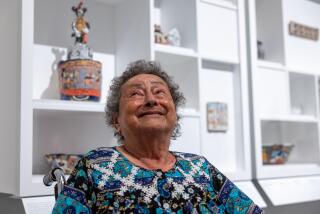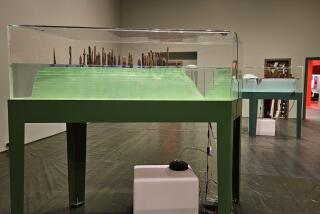Q&A: Jeff Koons on his new Gagosian show, his MOCA award and what’s behind those Louis Vuitton bags
Jeff Koons is having a moment — again. The artist’s solo show of new and recent works, his first here in five years, opens at Gagosian gallery in Beverly Hills on Thursday. He’s also being honored at the annual Museum of Contemporary Art gala on Saturday.
The gala promises to be a bright and shiny thank you of sorts honoring the artist’s creative work and his philanthropy. During the last five years, Koons helped to raise more than $5 million for the museum.
But Koons, who holds the record for the highest auction sale of any living artist with his $58.4 million “Balloon Dog (Orange), 1994–2000,” has turned up in headlines recently for other reasons as well. In March, a French court ruled that his 1988 porcelain sculpture, “Naked,” was plagiarized from French photographer Jean-Francois Bauret’s 1970 photograph, “Enfants” — something he declined to discuss in this interview. And his recent project for Louis Vuitton, “Masters,” featuring original designs for a 51-piece line of handbags, scarves, leather goods and other accessories, delighted some people but struck others as overly commercial art appropriation.
The ever-colorful Koons, who will have a 45-foot-tall ballerina sculpture unveiled in New York’s Rockefeller Center in May, takes it all in stride. “I’m always trying to be the best artist that I can be,” he said in this edited interview. “To reach a higher level of consciousness with my work.”
The Gagosian exhibition features new and recent works from the “Gazing Ball,” “Antiquity” and “Celebration” series. What’s the through-line?
What all these different works share in common is the use of reflection. So whether it’s one of the sculptures, a plaster cast, like Hercules with a gazing ball on his shoulder, or the surface of the Sacred Heart, from “Celebration,” a ballerina from the “Antiquity” series, all the works, the surface is reflective. They all share that in common.
Not just physically reflective, though. Gagosian refers to it as sort of metaphysical dialogue with cultural history.
I’ve always thought of these works, especially the “Gazing Ball” works and the “Antiquity” pieces, they’re playing with metaphysics because in the reflective, you have the right here, right now. It’s affirming you, it’s affirming any movement you may make, everything’s dependent on you. But at the same time, it’s reflecting a historical object or a painting or some of the sculptures have gradations painted on them which are another depiction of time — and all these things play with the idea of the past and present and you have a sense of the future through your own potential.
Between the MOCA gala and the Gagosian show, do you feel you’re having something of an L.A. moment?
It’s always wonderful to have exhibitions, it’s always a thrill to be involved with different institutions. And to feel a part of those institutions. It’s wonderful about MOCA. But, you know, an artist is always involved with their creative process and trying to make things that celebrate art. And how art continues to help us become who we can be.
There are so many people MOCA could be celebrating, so its meaningful to me they are celebrating my contribution. But really, what’s important to me is to be there with friends. The aspects that are involved in it, the ideas within the art world, they’re really shared by a vast number of people and we’re all affected by each other, by different artists, different collectors, different writers. So it really ends up to be a celebration of, in a way, a whole generation. I think we’re celebrating the community as a whole.
You’ve been generous with MOCA, but cynics might say artists donating that generously to a museum might be trying to curry favor.
I don’t think that things really function that way. I think that artists, generally, are extremely generous to their communities. Not only aiding the museums, but there are many causes taking place in the world, different crises — anywhere from AIDS to supporting schools that children receive art education in. I think that if somebody’s operating in such a small context like that, it would be quite obvious. Of myself, with MOCA, I’ve never had a retrospective or been involved in any major way like that. [My contributions] have been to be able to support the organization. We started back in the ’90s and it’s continued from that time, and it’s to help support Los Angeles.
Tell us about the Louis Vuitton line. It’s self-referential and art historical at once, inspired by your “Gazing Ball” paintings and featuring reproductions of famous works by Rubens, Van Gogh, Da Vinci and others — their names spelled out in bling-y gold and silver lettering.
I really believe very much in my “Gazing Ball” series, both the sculptures and the paintings. For the Louis Vuitton bags, I wanted to take the same kind of usage of ready-made objects of art, but not using the ball on the bags but reference it only through the name of the artist. So on a bag of the Mona Lisa you’ll have the name “Da Vinci.” Or on Rubens’ “The Tiger Hunt,” you’ll have “Rubens.” Van Gogh’s “Wheat Field With Cypresses,” the name is working almost in a Platonistic type way, where you have a pure form, like a chair — chair is always a chair — so these names become like eternal forms. And they’re reflective, so there’s a reference to that series. These are heroes, the canon of Western art history, at least a portion of it, and the works are there in kind of a symbol of connectivity.
Regarding that sort of “connectivity,” what role does art appropriation play in your work? What’s behind your fascination with it?
When I went to art school, I was very involved in subjective art, what I would have dreamed the night before, very personal iconography, this kind of inward investigation. And I reached a point where I learned how to trust in myself. I was living in Chicago. This would have been in the mid-’70s. My mentor, Ed Paschke, told me, ‘Everything is already here, you just have to open yourself up to it.’ And he showed me where he got his source material. We went to tattoo parlors, clubs with reflective curtains and mysterious lighting. And I started this journey of the ready-made and seeing the world around me and incorporating it.
The idea of the ready-made — something pre-existing for usage — kind of always existed. But it’s really about celebrating a vocabulary. If you look at the letters in the alphabet, and all of the sudden there’d be restrictions on those letters, it would really eliminate the world of poetry. It’s the same with the visual world and incorporating the things around us that we’re familiar with. So it’s being able to articulate these familiarities, to be able to create a visual poetry.
Is it also a way to connect with the art viewer?
In working with things that are familiar, automatically it’s a little more disarming to the viewer. They’re more open to the dialogue, the communication can happen a little quicker. I’m always working with objects or images to remove judgment or a sense of hierarchy or any type of discrimination. The hierarchy of, ‘Oh, I can’t get involved with art because I don’t know what that means!’ But you never have to bring anything to art other than yourself at that moment. You are perfect. The experience is about your potential, you are the only thing that matters.
Follow me on Twitter: @debvankin
ALSO
Beverly Center as art gallery? How some big-name artists are behind those construction barricades
Shakespeare died 401 years ago, but original scripts from his era live on in a new digital archive
Review of L.A. Opera’s ‘Tales of Hoffmann’
L.A. Phil’s Reykjavík Festival begins with singing in teacups
More to Read
The biggest entertainment stories
Get our big stories about Hollywood, film, television, music, arts, culture and more right in your inbox as soon as they publish.
You may occasionally receive promotional content from the Los Angeles Times.











